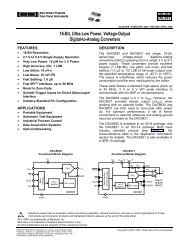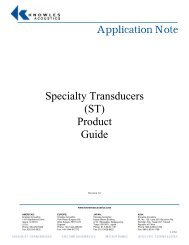DAC7631 - dreamm
DAC7631 - dreamm
DAC7631 - dreamm
You also want an ePaper? Increase the reach of your titles
YUMPU automatically turns print PDFs into web optimized ePapers that Google loves.
+5V<br />
+2.5000V<br />
1<br />
2<br />
V REF H<br />
V REF H Sense<br />
V CC<br />
AGND<br />
20<br />
19<br />
+<br />
0.1µF 1µF<br />
3<br />
V REF L<br />
V SS<br />
18<br />
Serial Data Out<br />
4<br />
5<br />
6<br />
7<br />
V REF L Sense V OUT Sense<br />
DGND<br />
<strong>DAC7631</strong><br />
V OUT<br />
V DD<br />
NC<br />
SDO<br />
RSTSEL<br />
17<br />
16<br />
15<br />
14<br />
0V to +2.5V<br />
Serial Data In<br />
Clock<br />
Chip Select<br />
8<br />
9<br />
10<br />
SDI<br />
CLK<br />
CS<br />
RST<br />
LOAD<br />
LDAC<br />
13<br />
12<br />
11<br />
Reset DAC Registers<br />
Load<br />
Load DAC Registers<br />
FIGURE 2. Basic Single-Supply Operation.<br />
+5V<br />
+5V<br />
+<br />
0.1µF 1µF<br />
+2.5000V<br />
–2.5000V<br />
Serial Data Out<br />
1<br />
2<br />
3<br />
4<br />
5<br />
6<br />
7<br />
V REF H<br />
V REF H Sense<br />
V REF L<br />
V REF L Sense<br />
V CC<br />
AGND<br />
V SS<br />
V OUT Sense<br />
DGND<br />
<strong>DAC7631</strong><br />
V OUT<br />
V DD<br />
NC<br />
SDO<br />
RSTSEL<br />
20<br />
19<br />
18<br />
17<br />
16<br />
15<br />
14<br />
+<br />
0.1µF 1µF<br />
+<br />
0.1µF 1µF<br />
–5V<br />
–2.5V to +2.5V<br />
Serial Data In<br />
Clock<br />
Chip Select<br />
8<br />
9<br />
10<br />
SDI<br />
CLK<br />
CS<br />
RST<br />
LOAD<br />
LDAC<br />
13<br />
12<br />
11<br />
Reset DAC Registers<br />
Load<br />
Load DAC Registers<br />
FIGURE 3. Basic Dual-Supply Operation.<br />
ANALOG OUTPUTS<br />
When V SS = –5V (dual supply operation), the output amplifier<br />
can swing to within 2.25V of the supply rails, guaranteed<br />
over the –40°C to +85°C temperature range. When<br />
V SS = 0V (single-supply operation), and with R LOAD also<br />
connected to ground, the output can swing to ground. Care<br />
must also be taken when measuring the zero-scale error<br />
when V SS = 0V. Since the output voltage cannot swing<br />
below ground, the output voltage may not change for the<br />
first few digital input codes (0000 H , 0001 H , 0002 H , etc.) if<br />
the output amplifier has a negative offset. At the negative<br />
limit of –2mV, the first specified output starts at code 0040 H .<br />
Due to the high accuracy of these D/A converters, system<br />
design problems such as grounding and contact resistance<br />
become very important. A 16-bit converter with a 2.5V fullscale<br />
range has a 1LSB value of 38µV. With a load current<br />
of 1mA, series wiring and connector resistance of only<br />
40mΩ (R W2 ) will cause a voltage drop of 40µV, as shown in<br />
Figure 4. To understand what this means in terms of a<br />
system layout, the resistivity of a typical 1 ounce copperclad<br />
printed circuit board is 1/2 mΩ per square. For a 1mA<br />
load, a 10 milli-inch wide printed circuit conductor 600<br />
milli-inches long will result in a voltage drop of 30µV.<br />
The <strong>DAC7631</strong> offers a force and sense output configuration<br />
for the high open-loop gain output amplifier. This feature<br />
allows the loop around the output amplifier to be closed at<br />
the load (as shown in Figure 4), thus ensuring an accurate<br />
output voltage.<br />
REFERENCE INPUTS<br />
The reference inputs, V REF L and V REF H, can be any voltage<br />
between V SS + 2.5V and V CC – 2.5V, provided that V REF H<br />
is at least 1.25V greater than V REF L. The minimum output of<br />
each DAC is equal to V REF L plus a small offset voltage<br />
(essentially, the offset of the output op amp). The maximum<br />
output is equal to V REF H plus a similar offset voltage. Note<br />
that V SS (the negative power supply) must either be<br />
connected to ground or must be in the range of –4.75V to<br />
–5.25V. The voltage on V SS sets several bias points within<br />
the converter. If V SS is not in one of these two configurations,<br />
the bias values may be in error and proper operation<br />
of the device is not guaranteed.<br />
®<br />
<strong>DAC7631</strong><br />
12















